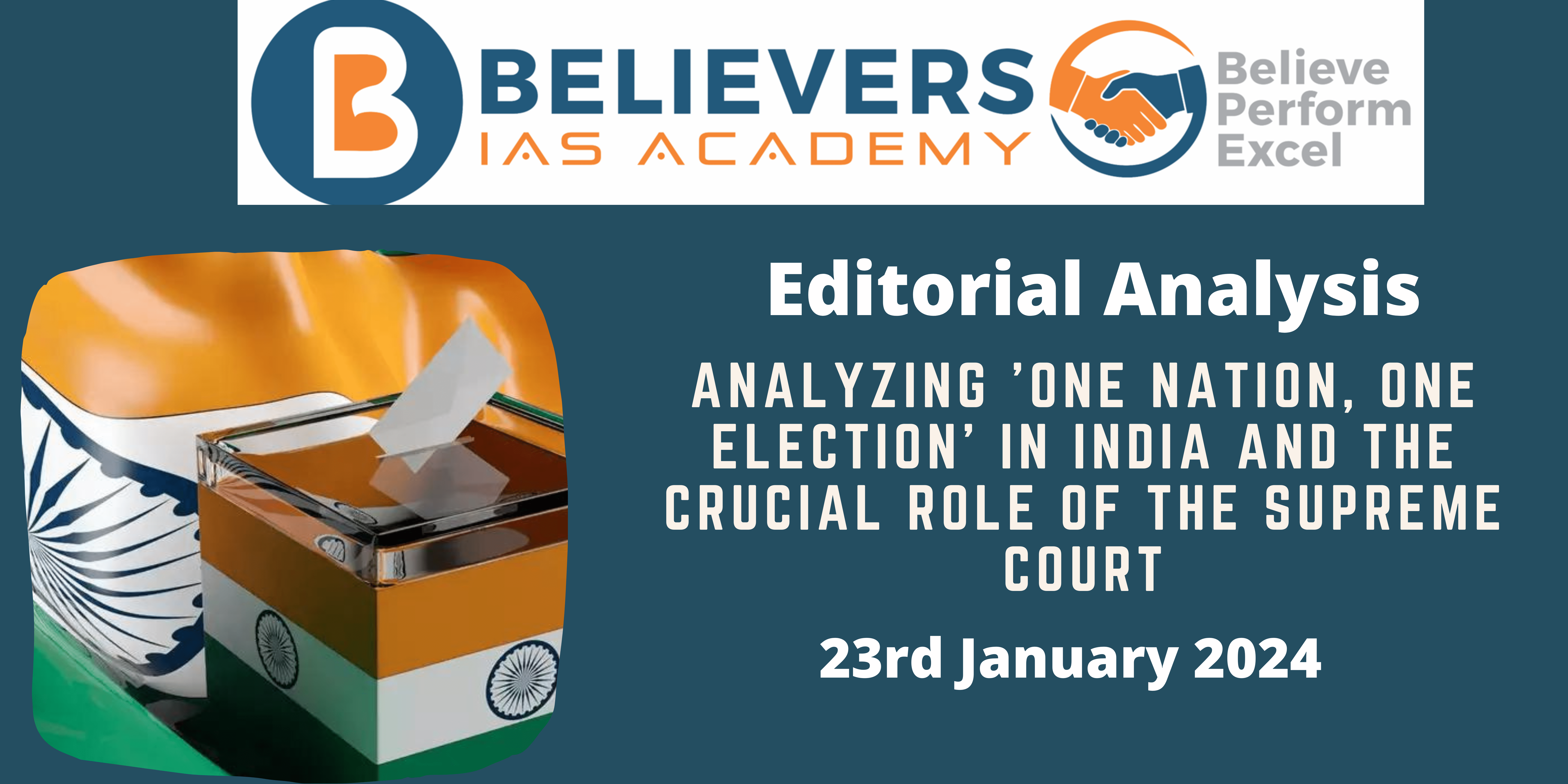Analyzing ‘One Nation, One Election’ in India and the Crucial Role of the Supreme Court
Context:
In September 2023, the Union Government initiated the ‘High Level Committee on One Nation, One Election,’ chaired by former President Ramnath Kovind. While the Committee seeks a unified election schedule, concerns arise about potential legal implications and alterations to the democratic framework. The Supreme Court’s role in scrutinizing this transformative proposal becomes crucial.
Relevance:
GS-02 (Government Policies and interventions)
Prelims:
- One Nation, One Election
- ECI
- Basic structure of the Constitution
- Article 368
Mains Question:
Critically analyze the legal and constitutional implications of the proposed ‘One Nation, One Election’ initiative in India. Discuss the role of the Supreme Court and other constitutional bodies in preserving the federal structure and democratic principles in the face of such transformative proposals. (250 words)
Dimensions of the Article:
- Examination of Reasons for Common Elections
- Legal Implications and Constitutional Concerns
- Language Bias in Consultation Process
- Election Commission’s Role and Autonomy
- Constitutional Showdown and Judicial Review
- Benefits of One Nation, One Election
- Challenges Associated with One Nation, One Election
Examination of Reasons for Common Elections:
- Supporters argue that a unified election schedule would curb expenses, citing the substantial cost of the 2014 general elections.
- Additionally, they contend that the Model Code of Conduct, effective twice in five years, disrupts governance.
- Opponents counter these points, asserting that the cost of democratic elections is a just investment, and the Model Code of Conduct safeguards a fair electoral process.
Legal Implications and Constitutional Concerns:
- In the landmark S.R. Bommai v. Union of India (1994) case, the Supreme Court affirmed the independent constitutional existence of States.
- A move towards One Nation, One Election would necessitate altering the tenure of State Legislatures, conflicting with constitutional provisions.
- Any action affecting a State’s independent constitutional existence would be deemed anti-federal and unconstitutional.
Language Bias in Consultation Process:
- A critical examination of the High Level Committee’s website reveals a potential bias. The platform, intended for stakeholder interaction, is available only in English and Hindi, neglecting the diversity of India’s 22 official languages.
- This linguistic exclusion raises concerns about bias, inequality, and a lack of inclusivity in the consultation process.
Election Commission’s Role and Autonomy:
- The autonomy of the Election Commission, a constitutional body entrusted with independent electoral decisions, comes into question. Similar to instances like demonetization, where the Reserve Bank of India was uninformed, the Election Commission appears passive in the face of the Committee’s actions.
- This prompts scrutiny into the potential compromise of the Election Commission’s independence.
Constitutional Showdown and Judicial Review:
- While the U.K. relies on parliamentary supremacy, India grants its higher courts extensive powers of judicial review.
- The proposed One Nation, One Election raises the specter of a constitutional showdown, questioning whether the Supreme Court will “enter the political thicket.”
- The impending constitutional debate underscores the need for courts to navigate this thicket to preserve India’s constitutional architecture.
Benefits of One Nation, One Election:
- Focused Governance:
- Enables the government to concentrate on governance post-elections.
- Frequent elections lead to a virtual paralysis of administration, hindering India’s growth prospects.
- Involvement of key political figures in elections diverts attention from routine administrative tasks.
- Continuity in Policy Decisions:
- Model Code of Conduct during elections delays key policy decisions.
- Ongoing project implementation faces disruptions as officials engage in election duties.
- Simultaneous elections promote policy continuity and streamline decision-making processes.
- Reduced Cost of Elections:
- Frequent elections contribute to political corruption and increased fundraising.
- Simultaneous elections drastically reduce election expenses for political parties.
- Savings for the public and business community by avoiding multiple rounds of election donations.
- Reduced Deployment of Security Forces:
- Simultaneous elections reduce the massive redeployment of security forces.
- Curtails costs associated with maintaining law enforcement personnel for election security.
- End of Horse Trading:
- Fixed intervals for elections may reduce horse-trading and party switching by elected representatives.
- Stability in election schedules makes it harder for representatives to form alliances for personal gains.
- Reduced Freebies and Improved State Finances:
- Frequent elections lead to policy decisions aimed at wooing voters with freebies.
- Smaller number of elections could alleviate financial strain on state governments.
- Improved state finances as governments have less pressure to announce populist measures.
Challenges Associated with One Nation, One Election:
- Feasibility:
- Constitutional provisions stipulate fixed tenures, raising questions about what happens mid-tenure if a government collapses.
- Uncertainty regarding whether elections would be held again in every state or if President’s rule would be imposed.
- Logistical Challenges:
- Poses logistical challenges concerning electronic voting machines, personnel, and resources.
- Managing such a massive exercise may strain the resources of the Election Commission.
- Against the Idea of Federalism:
- ONOE challenges the concept of federalism by treating the entire nation as a singular entity, contradicting the idea of a “Union of States.”
- Legal Challenges:
- The existing constitutional framework, the Representation of the People Act 1951, and rules of procedure require amendments for simultaneous elections.
- The need for ratification from at least 50% of the states poses a considerable challenge.
- Overshadowing Regional Interests:
- Simultaneous elections may undermine regional interests as issues at the national and state levels differ.
- Studies suggest a high probability of winning both Lok Sabha and Assembly elections simultaneously, potentially neglecting distinctive state needs.
- May Not Be So Cost-Effective:
- Estimates show that synchronized elections may not significantly reduce costs.
- Initial costs for infrastructure and equipment may outweigh the projected long-term savings.
- Election Expenses Aren’t Always Bad:
- Economic research suggests that election spending benefits the economy by boosting private consumption and serving as a stimulus.
- The short-term increase in costs for simultaneous elections may not justify amending the constitution to save relatively small amounts per voter annually.
Way Forward and Conclusion:
- Preserving Constitutional Integrity: As the High Level Committee progresses, it becomes imperative to preserve the constitutional integrity of India. The potential alteration of State tenures, language biases, and the Election Commission’s role demand vigilant scrutiny to maintain the essence of federalism and democratic principles.
- Ensuring Inclusive Consultation: Addressing language biases is crucial for an inclusive consultation process. A multilingual platform would ensure that diverse perspectives from across the linguistic landscape of India contribute to the deliberations on One Nation, One Election.
- Upholding Election Commission Autonomy: Safeguarding the autonomy of the Election Commission is pivotal. The Commission’s independence should be fortified to prevent undue influence, ensuring transparent and unbiased electoral processes.
- Constitutional Showdown and Judicial Role: The evolving situation sets the stage for a constitutional showdown. The role of the judiciary, especially the Supreme Court, is pivotal in safeguarding the constitutional framework. The looming question is whether the courts will intervene to protect India’s democratic structure.


